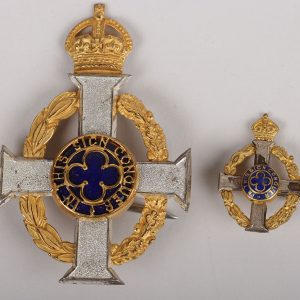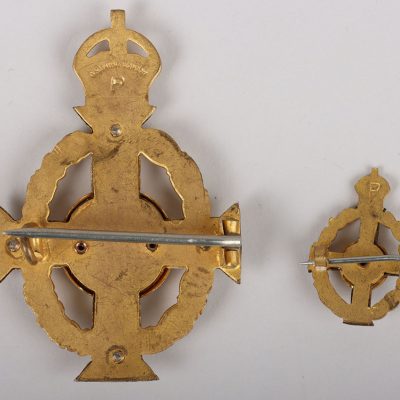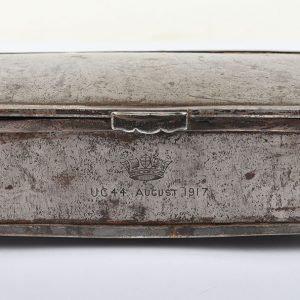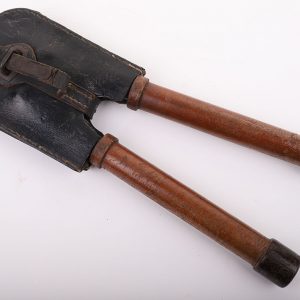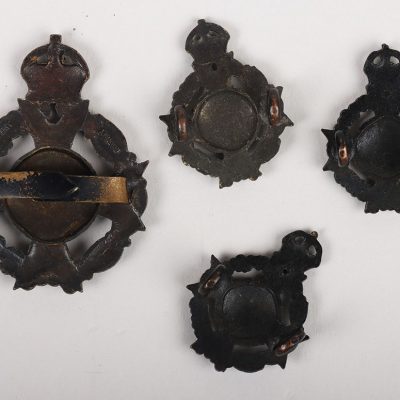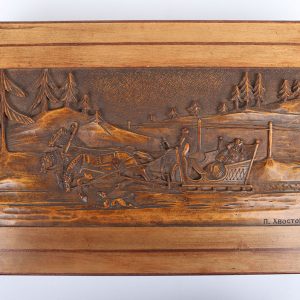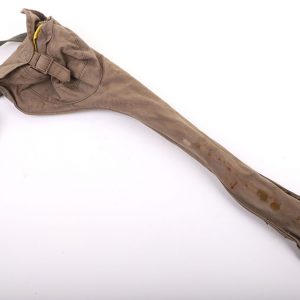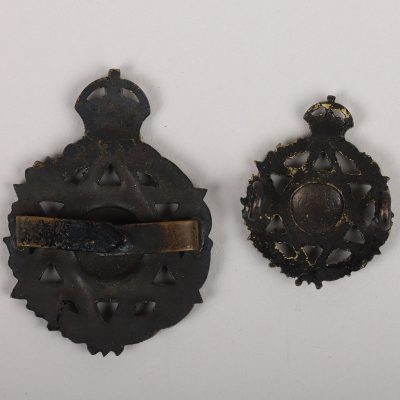Цены, указанные на сайте, могут быть изменены.
Для уточнения актуальных цен свяжитесь с нами или воспользуйтесь формой обратной связи.
Отображение 833–848 из 3607
Фильтры-
#120 – WW1 Steel Cigarette Box Made from Material Salvaged from Imperial German U-Boat UC44 (Лот: 5117)
Аукцион завершенМинимальная цена продажи 150 £ не достигнутаWW1 Steel Cigarette Box Made from Material Salvaged from Imperial German U-Boat UC44, Well made and marked with monogram letters WCW on lid and RN coronet and UC 44 August 1917 to the front side. Wooden lined, on silver bun feet with lid lining marked in ink ‘Turkish’, ‘Egypt’ and ‘Virginian’, presumably indicating the type of cigarette in each compartment. Some wear but generally good condition and consistent with its age and history. SMUC-44was a GermanType UC IIminelayingsubmarineorU-boatin duringWorld War I. Ordered on 20 November 1915,launchedon 10 October 1916 and commissionedinto the German Imperial Navy on 4 November 1916.In 6 patrolsUC-44was credited with sinking 28 ships, either by torpedo or bymineslaid and she was ultimatelywas sunk by the detonation of one of her own mines off the Irish coast on 4th August 1917; its commander, Kurt Teppenjohanns, was the only survivor.UC-44’s wreck was raised by theRoyal Navyin September 1917 and laterbroken up. Two aspects of her service are noteworthy.UC-44was the first submarine to use the tactic of releasing oil and debris from hertorpedo tubestofool the enemyinto believing it had been sunk bydepth charges. Her actual sinking, sometimes claimed to be the result of British deception, also yielded intelligence that showed how little effect theDover Barrageanti-submarine defences were having on the U-boats and forced changes in its command and operation before the year ended.
-
#120 – German Reichsmarine 1929 Pattern Naval Officers Dagger by E & F Horster, Solingen (Лот: 7309)
Ставки принимаются через менеджераGerman Reichsmarine 1929 Pattern Naval Officers Dagger by E & F Horster, Solingen, good example of the flame pommel top dagger, white celluloid grip with wire binding, brass cross guard with fouled anchor and press stud. Officers bullion dress knot / portepee attached to the grip. Housed in its original scabbard with two hanging rings. Fine double edged blade with fine etched decoration with fouled anchor and foliage. Blade measures 25 ¼ cms, overall 40cms.
-
#120 – Superb Second World War Distinguished Service Cross and Second Award Bar Meal Group of Seven Attributed to Commander Harold Bernard Samways Whose First Award Was for Service on H.M.S. Onslow for Convoy J.W.51B in December 1942 in What Became Known as the Battle of the Barents Sea when the Vessels Captain was Awarded a Victoria Cross, the Second Award Being for HMS Carlisle When She was Attacked and Badly Damaged by Enemy Aircraft in the Mediterranean in October 1943 (Лот: 8712)
Ставки принимаются через менеджераSuperb Second World War Distinguished Service Cross and Second Award Bar Meal Group of Seven Attributed to Commander Harold Bernard Samways Whose First Award Was for Service on H.M.S. Onslow for Convoy J.W.51B in December 1942 in What Became Known as the Battle of the Barents Sea when the Vessels Captain was Awarded a Victoria Cross, the Second Award Being for HMS Carlisle When She was Attacked and Badly Damaged by Enemy Aircraft in the Mediterranean in October 1943, Distinguished Service Cross, reverse officially dated 1943, with second award bar, the reverse dated 1944, 1939-45 Star medal, Atlantic Star medal, Africa Star medal with clasp North Africa 1942-43, Italy Star medal, Defence medal and War medal 1939-45, medals unnamed as issued and court mounted for wearing. With matching set of miniature medals. This lot also includes the following items; Buckingham Palace enclosure slip, Letter Confirming the award of the D.S.C. dated 8th April 1943, Photograph of H.M.S. Onslow showing battle damage after the Battle of the Barents Sea, Newspaper cutting relating the death of Harold Samways at the age of 68. Photograph of the recipient in his uniform, Hallmarked silver ashtray with the crest of HMS Renown, Hallmarked silver trinket dish, engraved HBS from CM HMS Eagle 1937-38, Hallmarked silver cigarette case, engraved HBS HMS Velox 4th May 1933 with signatures, Copy of the book ’73 North’ by Dudley Pope which covers the Battle of the Barents Sea in some detail.istinguished Service Cross, London Gazette 23rd March 1943 – For distinguished, services against the Enemy. Commander (E) Harold Bernard Samways, Royal Navy.ar to the Distinguished Service Cross, London Gazette 4th April 1944 – For undaunted courage, determination and endurance in H.M. Ships Sinus, Penelope, Carlisle, Aurora, Belvoir, Hurworth, Echo, Faulknor, Pathfinder, Penn, Fury, Beaufort, Jervis, Hursley, Intrepid, Petard, Eclipse, Rockwood, Dulverton, Croome, Aldenham, Blencathra, the Polish Ship Krakowiak, the Greek Ship Adrias and in Light Coastal Forces in many sweeps against enemy shipping in the Aegean under fierce and constant attack from the air, and in maintaining supplies to the islands of Kos and Leros until they fell to superior enemy forces. Commander (E) Harold Bernard Samways. D.S.C., Royal Navy (Petersfield, Hants).he Battle of the Barents Sea was based around the convoy JW51B, carrying supplies to the USSR with the flotilla leader being the Onslow (Captain R. St. V. Sherbrooke, D.S.O.). To begin with the enemy heavy cruiser, Hipper, was reluctant to close, fearful of a torpedo strike due to Sherbrooke making a clever dummy turn, but inevitably, as described in 73 North, Admiral Kummetz, aboard the Hipper, regained his nerve: ‘Kummetz realized he had been outmanoeuvred by Sherbrooke in his first attack on the convoy and prepared for the second. He turned the Hipper eastwards at 0957 on to a course parallel to the Onslow and Orwell and opened fire with all four turrets. However, both destroyers fired back vigorously and three minutes later the Hipper altered away to the obscurity of the north-east. All the time Kummetz was being driven farther away from the convoy, and although this meant that because of the bad light and the shortcomings of the radar it was out of effective range of his guns, it would perhaps give the Lutzow a better chance when she attacked from the south. Then he saw the enemy had followed round boldly – almost impertinently – on his starboard quarter, carefully keeping between him and the merchantmen. Four minutes later, at 1004, he decided to make his third sally and this time the Hipper came round to the south-east to a course converging on the Onslow and Orwell. For four minutes she steamed along, her 8-inch guns blazing away. But although the two British destroyers weaved to dodge the shells, they still stubbornly steered in an easterly direction, effectively cutting Kummetz off from the convoy. Once again, at 1008, he took the Hipper away to the north-east and ceased firing, as if to regain his breath. Then at 1013 he decided to make a fourth attack and turned the Hipper to the south-east to bring all her eight 8-inch guns and as many of the 4.1-inch anti-aircraft guns as possible to bear on the two destroyers and overwhelm them. At the same time he signalled to his force: ‘Hipper to the north of the convoy and there are four enemy destroyers between us and the convoy.’ This was an ambiguous signal because the Onslow and Orwell were the only two ships then fighting him off. Kummetz’s own three destroyers now formed up astern of the Hipper, which was increasing speed and firing fast at the Onslow and Orwell. They in turn were steaming along just forward of her beam. It was an unequal contest and, since the Hipper’s gunners would soon get the Onslow’s range, it could surely have only one outcome. The Hipper’s eight 8-inch guns fired a broadside weighing more than 2000 lb., and the six 4.1-inch anti-aircraft guns added another 200 lb. In reply the Onslow’s two guns (two were still frozen up) fired a 96 lb. reply and the Orwell’s four 4-inch guns a 124 lb. broadside. A total of more than 2200 lb. versus 220 lb. Thus the Hipper had the advantage of being able to fire nearly a ton more of high explosives and in addition she knew the guns of the Onslow and Orwell could do her little harm … ‘ What followed led to the award of the Victoria Cross to Sherbrooke of the Onslow, for it was to his command that the Hipper first turned her attention, again and again ominous red glows rippling along the enemy cruiser’s side as she fired her 8-inch guns – several found their mark, turning the little destroyer into a mass of flames forward, but Sherbrooke remained very much in command on the bridge, despite being grievously wounded by a shell splinter – his left eye was hanging down his face. 73 North continues: ‘From astern Austen, in the Orwell, had seen the salvos falling near the Onslow; then the flash of a hit on the funnel was followed by the two hits forward and the whole ship dissolved into a cloud of smoke and steam which streamed aft from a pulsating nucleus of fire. He thought she was going to blow up and immediately came round to port to keep clear. A few moments later he saw her alter away to starboard. Immediately the Hipper’s gunners switched target and her 8-inch salvos started falling with deadly monotony round the Orwell. Austen ordered her to make smoke to help screen the Onslow and flotilla leader, the Onslow (Captain R. St. V. Sherbrooke, D.S.O.). To begin with the enemy heavy cruiser was reluctant to close, fearful of a torpedo strike due to Sherbrooke making a clever dummy turn, but inevitably, as described in 73 North, Admiral Kummetz, aboard the Hipper, regained his nerve: ‘Kummetz realized he had been outmanoeuvred by Sherbrooke in his first attack on the convoy and prepared for the second. He turned the Hipper eastwards at 0957 on to a course parallel to the Onslow and Orwell and opened fire with all four turrets. However, both destroyers fired back vigorously and three minutes later the Hipper altered away to the obscurity of the north-east. All the time Kummetz was being driven farther away from the convoy, and although this meant that because of the bad light and the shortcomings of the radar it was out of effective range of his guns, it would perhaps give the Lutzow a better chance when she attacked from the south. Then he saw the enemy had followed round boldly – almost impertinently – on his starboard quarter, carefully keeping between him and the merchantmen. Four minutes later, at 1004, he decided to make his third sally and this time the Hipper came round to the south-east to a course converging on the Onslow and Orwell. For four minutes she steamed along, her 8-inch guns blazing away. But although the two British destroyers weaved to dodge the shells, they still stubbornly steered in an easterly direction, effectively cutting Kummetz off from the convoy. Once again, at 1008, he took the Hipper away to the north-east and ceased firing, as if to regain his breath. Then at 1013 he decided to make a fourth attack and turned the Hipper to the south-east to bring all her eight 8-inch guns and as many of the 4.1-inch anti-aircraft guns as possible to bear on the two destroyers and overwhelm them. At the same time he signalled to his force: ‘Hipper to the north of the convoy and there are four enemy destroyers between us and the convoy.’ This was an ambiguous signal because the Onslow and Orwell were the only two ships then fighting him off. Kummetz’s own three destroyers now formed up astern of the Hipper, which was increasing speed and firing fast at the Onslow and Orwell. They in turn were steaming along just forward of her beam. It was an unequal contest and, since the Hipper’s gunners would soon get the Onslow’s range, it could surely have only one outcome. The Hipper’s eight 8-inch guns fired a broadside weighing more than 2000 lb., and the six 4.1-inch anti-aircraft guns added another 200 lb. In reply, the Onslow’s two guns (two were still frozen up) fired a 96 lb. reply and the Orwell’s four 4-inch guns a 124 lb. broadside. A total of more than 2200 lb. versus 220 lb. Thus the Hipper had the advantage of being able to fire nearly a ton more of high explosives and in addition she knew the guns of the Onslow and Orwell could do her little harm … ‘ What followed led to the award of the Victoria Cross to Sherbrooke of the Onslow, for it was to his command that the Hipper first turned her attention, again and again ominous red glows rippling along the enemy cruiser’s side as she fired her 8-inch guns – several found their mark, turning the little destroyer into a mass of flames forward, but Sherbrooke remained very much in command on the bridge, despite being grievously wounded by a shell splinter – his left eye was hanging down his face. 73 North continues: ‘From astern Austen, in the Orwell, had seen the salvos falling near the Onslow; then the flash of a hit on the funnel was followed by the two hits forward and the whole ship dissolved into a cloud of smoke and steam which streamed aft from a pulsating nucleus of fire. He thought she was going to blow up and immediately came round to port to keep clear. A few moments later he saw her alter away to starboard. Immediately the Hipper’s gunners switched target and her 8-inch salvos started falling with deadly monotony round the Orwell. Austen ordered her to make smoke to help screen the Onslow and at this point Hipper turned away, retiring to the east into the dark anonymity of a convenient snow squall. 17 members of Onslow crew were killed and 23 wounded in this encounter. Onslow went on to Murmansk for temporary repairs before making an uneventful return to the UK for repairs as part of convoy RA 52. amways bar was awarded for service on board H.M.S. Carlisle In July 1943, she escorted the support force for the Allied invasion of Sicily. In September–October, during the German counter-attack in the Aegean Sea, Carlisle made a sortie into the area south of Piraeus with the destroyers H.M.S. Panther and HMS Rockwood; intercepting German convoys in the Scarpanto Strait. On 9 October 1943, they were spotted by German Ju87 dive bombers from I. StG 3 from the Megara air base which succeeded in sinking Panther at 12.05 and later on seriously damaged Carlisle; killing 24 members of the ship’s company. She was taken in tow to Alexandria by Rockwood. She was considered to be beyond economical repair as a warship
-
#120 – Royal Army Chaplain Department Cap Badge and Collar Badge by J R Gaunt (Лот: 10186)
Ставки принимаются через менеджераRoyal Army Chaplain Department Cap Badge and Collar Badge by J R Gaunt, fine blackened bronze kings crown cap badge with blae fittings to the reverse. Makers mark also to the reverse. Accompanied by a single collar badge with lug fittings. Also accompanied by a pair of blackened collar badges repute to have been made by Pitt & Co. (4 items)
-
#121 – German Reichsmarine / Third Reich Transitional Pattern Naval Officers Dress Dagger by Paul Weyersberg & Co, Solingen (Лот: 7310)
Ставки принимаются через менеджераGerman Reichsmarine / Third Reich Transitional Pattern Naval Officers Dress Dagger by Paul Weyersberg & Co, Solingen, example with white celluloid grip having the wire binding still present. Brass Kriegsmarine eagle pommel top. Cross guard with fouled anchor to the centre of each side, interesting no press stud for the release spring to the cross guard. Attached to the grip is the original officers bullion knot / portepee. Housed in its original deluxe hammered scabbard. The top of the scabbard throat is stamped with the Reichsmarine acceptance stamp. Plain double edged blade with makers trade mark to the base, Reichsmarine acceptance stamp below the trademark to the base of the blade. The blade has the scooped out section for the spring catch to be fitted but obviously removed when converted to Kriegsmarine period. Blade shows some wear with staining. The blade measures 23 ½ cms, overall 40cms. Due to the removal of the spring catch, dagger fits very tight into the scabbard.
-
#121 – Fine Second World War Fleet Air Arm Distinguished Service Cross Group of Five to 1770 Squadron for Attacks on the German Battleship Tirpitz whilst in Alten Fjord Norway (Лот: 8713)
Ставки принимаются через менеджераFine Second World War Fleet Air Arm Distinguished Service Cross Group of Five to 1770 Squadron for Attacks on the German Battleship Tirpitz whilst in Alten Fjord Norway, Distinguished Service Cross, reverse officially dated 1945, 1939-45 Star medal, Atlantic Star medal, Africa Star medal with clasp North Africa 1942-43 and War medal 1939-45. Group unnamed as issued and mounted as worn. Group includes some original documentation, Admiralty issue slip for Second World War campaign medals (4 issued), group photograph including recipient in front of aircraft, other photographs of aircraft landing on an aircraft carrier, letter of confirmation of award of the D.S.C. to ‘TEMPORARY LIEUTENANT (A) IAN HUGH MCALISTER GUNN D.S.C. R.N.V.R.’ and dated 19th January 1945.istinguished Service Cross, London Gazette, 16rh January 1945 – For undaunted courage, skill and determination in carrying out daring attacks on the German battleship Tirpitz.- Temporary Lieutenant (A) Ian Hugh MacAlister Gunn, R.N.V.R. (Hampstead).eedie’s confirms the award for 4 attacks on the Tirpitz in Altenfjord in August 1944, McAlister received his award at an investiture on 13th November 1945.
-
#122 – Russian Civil War Bolshevik Prisoner of War Decorated Box in the Bilibin Style (Лот: 5119)
Аукцион завершенМинимальная цена продажи 200 £ не достигнутаRussian Civil War Bolshevik Prisoner of War Decorated Box in the Bilibin Style, believed to be produced in one of Admiral Kokhaks camps in 1919. Stained and painted rectangular wooden box with scene of St Nicholas to the lid. Compartment divider to the inside. Box dimensions, 35 x 25 x 10cms. Provenance from the grandson of a British soldier who assisted the Red Cross in bringing aid to prisoners.
